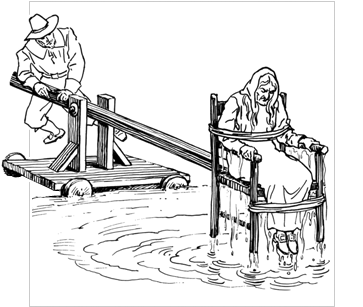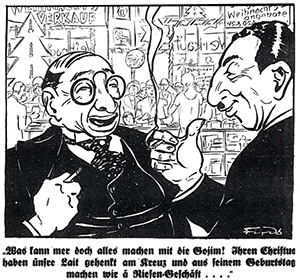Ducking-stools and cucking-stools are chairs formerly used for punishment. They were both instruments of social humiliation and censure, primarily for the offense of scolding or back biting, and less often for sexual offenses like having an illegitimate child or prostitution. They were technical devices which formed part of the wider method of law enforcement through social humiliation.
Most were simply chairs into which the victim could be tied and exposed at her door or the site of her offence and publicly shamed. Some were on wheels and could be dragged around the parish. Some were put on poles so that they could be plunged into water, hence ‘ducking’ stool.
read more »
Cucking Stool
Kangura
Kangura was a Kinyarwanda- and French-language magazine in Rwanda that served to stoke ethnic hatred in the run-up to the Rwandan Genocide. It was established in 1990, following the invasion of the rebel Rwandan Patriotic Front (RPF), and continued publishing up to the genocide. Sponsored by the dominant MRND party and edited by founder Hassan Ngeze, the magazine was a response to the RPF-sponsored Kanguka, adopting a similar informal style.
‘Kangura’ was a Kinyarwanda word meaning ‘wake others up,’ as opposed to ‘Kanguka,’ which meant ‘wake up.’ The magazine was the print equivalent to the later-established Radio Télévision Libre des Mille Collines (RTLM), publishing articles harshly critical of the RPF and of Tutsis generally. Its sensationalist news was passed by word-of-mouth through the largely illiterate population. Copies of Kangura were read in public meetings and, as the genocide approached, during Interahamwe militia rallies.
Der Stürmer
Der Stürmer (literally, ‘The Stormer;’ or more accurately, ‘The Attacker’) was a weekly Nazi newspaper published from 1923 to the end of World War II in 1945. It was a significant part of the Nazi propaganda machinery and was vehemently anti-Semitic. Unlike the ‘Völkischer Beobachter’ (‘The People’s Observer’), the official party paper which gave itself an outwardly serious appearance, the tabloid-style ‘Der Stürmer’ often ran obscene materials such as anti-Semitic caricatures and accusations of blood libel, pornography, anti-Catholic, anti-capitalist and anti-reactionary propaganda. The paper originated at Nuremberg; the first copy was published April 20, 1923. Its circulation grew over time, distributing to a large percentage of the German population as well as Argentina, Brazil, Canada and the United States.
‘Der Stürmer’ was best-known for its effective anti-semitic caricatures, which revealed Jews as ugly characters with exaggerated facial features and misshapen bodies. Many of these drawing were the work of Philipp Rupprecht, known as Fips, who was one of the best-known anti-Semitic cartoonists, his virulent attacks wedding ‘Jewish capitalists’ with ‘Jewish Communism.’ At the bottom of the title page there was always the motto ‘Die Juden sind unser Unglück!’ (‘The Jews are our misfortune!’), coined by German historian, Heinrich von Treitschke in the 1880s. The paper’s other motto was: ‘Deutsches Wochenblatt zum Kampfe um die Wahrheit’ (‘German Weekly Newspaper in the Fight for Truth’).
Folk Devil
A folk devil is a person or group of people who are portrayed in folklore or the media as outsiders and deviant, and are blamed for crimes or other sorts of social problems. The pursuit of folk devils frequently intensifies into a mass movement that is called a moral panic. When a moral panic is in full swing, the folk devils are the subject of loosely organized but pervasive campaigns of hostility through gossip and the spreading of urban legends. The concept of the folk devil was introduced by sociologist Stanley Cohen in 1972, in his study ‘Folk Devils and Moral Panics,’ which analyzed media controversies concerning the Mods and Rockers subcultures in the United Kingdom of the 1960s.
The basic pattern of agitations against folk devils can be seen in the history of witch hunts and similar manias of persecution (Christian Europeans branded adherents of the rival faiths folk devils). Minorities and immigrants have often been seen as folk devils; in the long history of anti-Semitism, which frequently targeted Jews with allegations of dark, murderous practices, such as blood libel; or the Roman persecution of Christians (blaming the military reverses suffered by the Roman Empire on the Christians’ abandonment of paganism). In modern times, political and religious leaders in many nations have sought to present atheists and secularists as deviant outsiders who threaten the social and moral order.
Area Code 321
Area code 321 is the area code serving Brevard County, Florida and home to the Kennedy Space Center. It has been in use since November 1, 1999, and was assigned to the area after a successful petition drive due to the Space Coast’s impact on the county (if pronounced properly – ‘three, two, one’– the code resembles the countdown which launches the many spacecraft from Cape Canaveral).
Tongue-in-cheek
Tongue-in-cheek is a figure of speech used to imply that a statement or other production is humorously or otherwise not seriously intended, and it should not be taken at face value. The facial expression typically indicates that one is joking or making a mental effort. In the past, it may also have indicated contempt, but that is no longer common. By 1842, the phrase had acquired its contemporary meaning. Early users of the phrase include Sir Walter Scott in his 1828 novel ‘The Fair Maid of Perth.’ The ironic usage originates with the idea of suppressed mirth—biting one’s tongue to prevent an outburst of laughter.
Putting one’s tongue into a cheek was formerly used to signify contempt. For example, in Scottish author Tobias George Smollett’s ‘The Adventures of Roderick Random,’ which was published in 1748, the eponymous hero is taking a coach to Bath and apprehends a highwayman. This provokes an altercation with a less brave passenger: ‘He looked black and pronounced with a faultering voice, ‘O! ’tis very well—damn my blood! I shall find a time.’ I signified my contempt of him by thrusting my tongue in my cheek, which humbled him so much, that he scarce swore another oath aloud during the whole journey.’
Grain of Salt
(With) a grain of salt is a literal translation of a Latin phrase, ‘(cum) grano salis.’ It is often used to show that intelligence and personal judgment are needed, as in ‘I drink wine cum grano salis since I must drive’ (with care, moderately) or ‘please, repair this electric cable cum grano salis’ (aware of the dangers). ‘Cum grano salis’ also means, like in modern English, that something should not be taken too literally. In Italy ‘to have salt on your pumpkin’ (pumpkin being your head) means to have intelligence and reasoning capabilities.
The phrase comes from Pliny the Elder’s ‘Naturalis Historia,’ regarding the discovery of a recipe for an antidote to a poison. In the antidote, one of the ingredients was a grain of salt. Threats involving the poison were thus to be taken ‘with a grain of salt’ and therefore less seriously. An alternative account says that the Roman general Pompey believed he could make himself immune to poison by ingesting small amounts of various poisons, and he took this treatment with a grain of salt to help him swallow the poison. In this version, the salt is not the antidote, it was taken merely to assist in swallowing the poison.
Parahawking
Parahawking combines paragliding and falconry. Birds of prey are trained to fly with paragliders, guiding them to thermals for in-flight rewards and performing aerobatic manoeuvres. It was developed by British falconer Scott Mason in 2001. Mason began a round-the-world trip in Pokhara, Nepal, where many birds of prey – such as the griffon vulture, steppe eagle and black kite – can be found. He has been based in Pokhara ever since, training and flying birds during the dry season between September and March.
The team started by training two black kites, but have since added an Egyptian vulture and a Mountain hawk-eagle to the team. Only rescued birds are used – none of the birds have been taken from the wild. Mason and Hill documented their endeavors, with help from colleague Graham Saunders-Griffiths, in a film entitled Parahawking.
Pruno
Pruno, or prison wine, is an alcoholic liquid variously made from apples, oranges, fruit cocktail, ketchup, sugar, and possibly other ingredients, including bread. Pruno originated in (and remains largely confined to) prisons, where it can be produced cheaply, easily, and discreetly. The concoction can be made using only a plastic bag, hot running water, and a towel or sock to conceal the pulp during fermentation. The end result has been colorfully described as a ‘vomit-flavored wine-cooler.’ Depending on the time spent fermenting, the sugar content, and the quality of the ingredients and preparation, pruno’s alcohol content by volume can range from 2 – 14%.
Typically, the fermenting mass of fruit — called the motor in prison parlance (from ‘promoter’) – is retained from batch to batch to make the fermentation start faster. Increasing sugar results in more alcohol until the waste products of fermentation kill the motor. This also causes the taste of the end product to suffer. Ascorbic acid or Vitamin C powder is sometimes used to stop the fermentation, which, combined with the tartness of the added acid, counteracts the cloyingly sweet flavor. In an effort to eradicate pruno, some wardens have gone as far as banning all fresh fruit from prison cafeterias. In such cases, inmates often resort to using sauerkraut and orange juice.
Dan Deacon
Dan Deacon (b. 1981) is an American electronic musician. Dan was born and raised in suburban Long Island, New York. After high school he attended the Conservatory of Music at State University of New York where, in addition to performing his solo material, he played in many bands, including tuba for Langhorne Slim and guitar in the improvisational grindcore band Rated R. He completed his graduate studies in electro-acoustic and computer music composition.
In 2004 he moved to Baltimore, Maryland and moved into the Copycat Building and, along with friends from SUNY Purchase, formed Wham City, an arts and music collective.
read more »
Green Boots
Green Boots is the name given to the corpse of Indian climber Tsewang Paljor (1968 – 1996) on the North face route of Mount Everest. There is little doubt that the body is that of Paljor, who was wearing green Koflach boots on the day he and two others apparently summited. On the way down, he fell victim to exposure in the storm of 10 May 1996 that killed seven others. Since the cave his corpse lies in is on the popular northern route, his body is encountered frequently and came to be known as ‘Green Boots.’
An area along the northeast route to the summit has earned the unassuming nickname of ‘Rainbow Valley,’ simply because of the multicolored down jackets of the numerous corpses littering the hillside. In the harsh conditions of lethal altitudes, corpses can remain for decades, some appearing frozen in time with climbing gear intact. Despite the snow and ice, Everest is as dry as a desert and the sun and wind quickly mummify human remains. In the 56 years since the first men in history reached the top, 216 people have died and 150 bodies have never been, and likely can never be, recovered. They are all still there, and located, almost without exception, in the Death Zone, where oxygen is only one third of the sea level value.
Ub Iwerks
Ub Iwerks (1901 – 1971) was an American animator and special effects technician who created several of Walt Disney’s early characters including Mickey Mouse. Iwerks was considered by many to be Disney’s oldest friend, and he spent most of his career working for Disney in some capacity. The two met in 1918 while working for the Kansas City Art Studio, and would eventually start their own commercial art business together.
read more »















